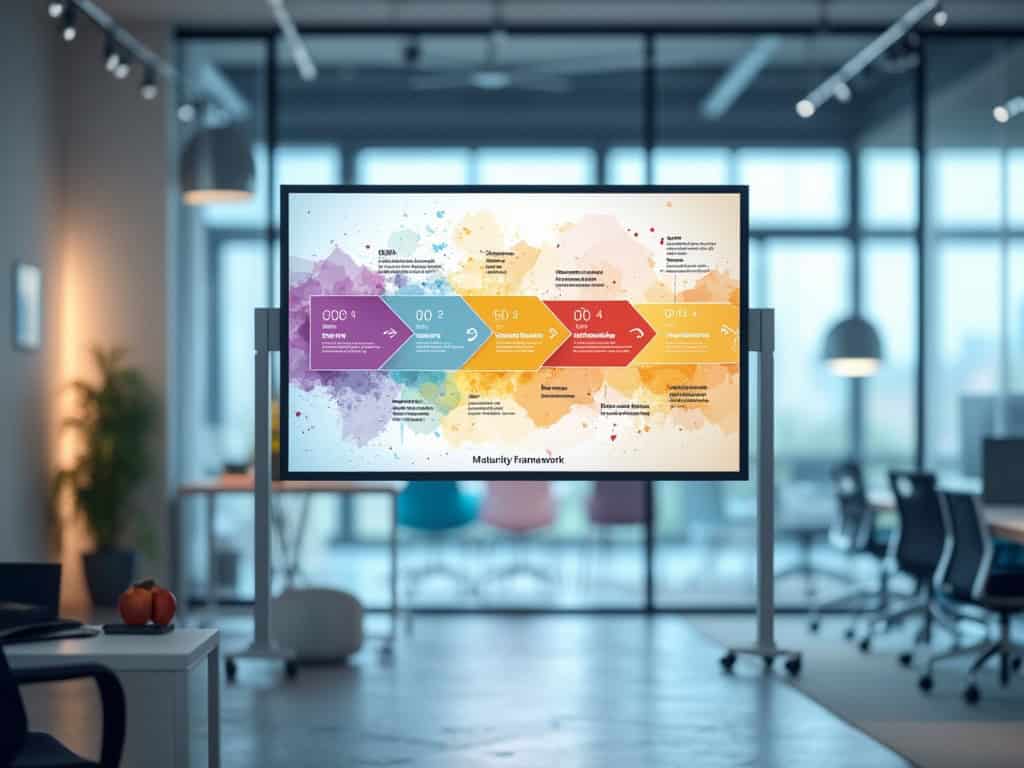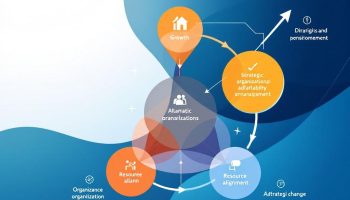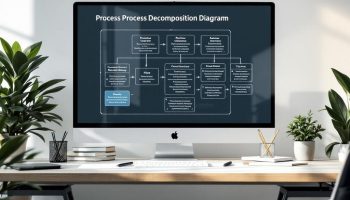
The Enterprise Architecture Management Maturity Framework provides a structured approach for organizations to develop their architectural capabilities across five key stages. This framework acts as a roadmap for businesses to advance from ad-hoc architectural practices to an optimized state where enterprise architecture functions as a strategic business enabler.
The Strategic Value of Architectural Maturity
The Enterprise Architecture Management Maturity Framework helps you systematically improve business-IT alignment while cutting operational inefficiencies and technical debt. As you progress through the maturity stages—from Initial to Optimized—you can transform your architecture practices from reactive documentation exercises into proactive strategic assets. These assets drive innovation and competitive advantage for your organization.
This structured approach assists you in managing enterprise-wide architectural decisions, ensuring your technology investments deliver measurable business outcomes. You’ll gain the flexibility needed to adapt to changing market conditions while maintaining architectural integrity. The framework provides clear benchmarks to assess your current capabilities and identify specific areas for improvement.
Understanding the 5 Key Stages of the Enterprise Architecture Management Maturity Framework: Elevate Your Organization Today
Enterprise architecture management maturity is essential for organizations striving to improve their strategic alignment and operational efficiency. This section outlines the five crucial stages of the enterprise architecture management maturity framework, from the Initial stage, where processes are largely informal, to the Optimized stage, where organizations demonstrate advanced capabilities and proactive management. Each stage presents unique challenges and opportunities for growth, helping organizations recognize where they currently stand and what steps to take for advancement. By understanding these stages, your organization can better navigate the complexities of enterprise architecture, optimize resource utilization, and drive sustainable innovation. Dive into the details of each stage to unlock the potential of your enterprise architecture management journey.
1. Initial (Ad hoc) Stage of Enterprise Architecture Maturity
The initial stage of the enterprise architecture management maturity framework represents the starting point for organizations beginning their EA journey. At this level, most EA processes remain informal with limited documentation and primarily reactive approaches to architecture challenges. Organizations typically respond to immediate business needs without considering long-term architectural implications.
Common challenges at this stage include a lack of standardization across departments, unclear governance structures, and siloed operations that hinder collaboration. Without established EA practices, businesses often struggle with inconsistent technology implementations and redundant systems that increase costs.
To progress beyond this stage, consider these strategies:
- Document existing processes and systems to create baseline architecture
- Identify key stakeholders who will champion the EA initiative
- Establish basic EA guidelines that align with strategic planning processes
- Create a simple inventory of applications and technology assets
- Begin developing awareness of EA benefits among leadership
Measuring progress at this stage focuses on establishing basic metrics like completed system inventories and initial documentation coverage. While this stage presents challenges, it provides valuable opportunities to lay the groundwork for more mature enterprise architecture frameworks.
2. Under Development Stage
In the Under Development stage of an enterprise architecture management maturity framework, organizations begin establishing foundational EA practices. During this phase, you’ll notice basic frameworks emerging with initial efforts to document architectural elements across the enterprise.
This critical phase builds the foundation for more structured EA approaches. You can identify this stage by the creation of preliminary architecture diagrams, basic component catalogs, and initial attempts to map business capabilities to technology assets.
Organizations face several common challenges at this level:
- Resistance to change from stakeholders accustomed to ad-hoc approaches
- Resource constraints limiting comprehensive architecture development
- Incomplete documentation with significant gaps in coverage
- Difficulty demonstrating immediate value to business leaders
To progress from this stage, implement these strategies:
- Deploy fundamental EA tools to standardize documentation
- Develop preliminary technology roadmaps aligned with business goals
- Secure executive sponsorship through strategic vision alignment
- Establish basic governance mechanisms for architecture decisions
- Create architecture review boards with clear roles and responsibilities
Tracking key metrics like the percentage of documented processes and stakeholder engagement levels helps measure your progress toward the next maturity stage.
Expert Insight: In the Under Development stage, focus on standardizing documentation and establishing preliminary architecture frameworks. Overcome resistance by securing executive sponsorship and demonstrating alignment with business goals. Track key metrics like documented processes and stakeholder engagement to gauge progress and enhance buy-in for future EA initiatives.
3. Defined Stage in the Enterprise Architecture Management Maturity Framework
In the Defined Stage of the enterprise architecture management maturity framework, organizations establish formalized EA processes and clear governance structures. This critical stage represents the point where EA practices become standardized across the entire organization, creating consistency and predictability. The enterprise architecture management maturity framework highlights this stage as the transition from ad-hoc approaches to systematic architecture management.
Organizations at this stage typically face several challenges including maintaining implementation consistency and sustaining momentum after initial successes. To make progress, you should focus on formalizing EA policies, establishing regular architecture review processes, and creating robust communication channels between IT and business units.
Key metrics to monitor at the Defined Stage include:
- Process compliance rates across departments
- Architecture coverage percentage
- Documentation completeness
- Governance adherence metrics
- Stakeholder engagement levels
The Defined Stage serves as a pivotal point in your strategic planning journey, building on earlier foundational work while preparing the organization for more advanced maturity levels. Success at this stage requires balancing standardization with flexibility to accommodate diverse business needs.
Expert Insight: At the Defined Stage of the enterprise architecture management maturity framework, organizations should prioritize formalizing EA policies and governance structures to ensure consistency across practices. Regular architecture reviews and strong communication between IT and business units are key to overcoming implementation challenges and sustaining momentum for progress.
4. Managed Stage in Enterprise Architecture Management Maturity Framework
In the Managed Stage of the enterprise architecture management maturity framework, your organization demonstrates proactive EA management that integrates seamlessly with business strategy. At this advanced level, EA functions as a strategic asset driving business value and innovation rather than merely documenting systems.
You’ll notice architecture decisions are consistently aligned with organizational objectives, creating measurable business benefits. The framework enables strategic planning that connects technology investments directly to business outcomes.
However, you may face several challenges at this stage:
- Balancing architectural flexibility with necessary controls
- Developing meaningful ROI measurements for EA initiatives
- Maintaining relevance amid changing business priorities
- Ensuring consistent application across all business units
To advance your enterprise architecture management maturity framework implementation, consider these progress strategies:
- Implement advanced EA modeling and analysis tools
- Establish a comprehensive metrics program tied to business goals
- Align architecture governance with project portfolio management processes
- Develop feedback mechanisms between business and IT teams
Track success through key metrics including business-IT alignment scores, project success rates influenced by EA guidance, and reduced technical debt measurements.
Expert Insight: In the Managed Stage of the enterprise architecture maturity framework, prioritize aligning architecture with business objectives while balancing flexibility and control. Implement robust metrics to measure ROI and support strategic planning, ensuring EA consistently drives innovation and business value. Foster collaboration between IT and business for sustained relevance and success.
5. Optimized Stage: Elevating Enterprise Architecture Management Maturity
The Optimized Stage represents the pinnacle of enterprise architecture management maturity framework implementation. At this level, your organization demonstrates continuous improvement capabilities and leverages predictive analytics to anticipate business needs. The enterprise architecture management processes become fully embedded in organizational DNA, enabling proactive strategic planning rather than reactive responses.
In this mature stage, the significance of your enterprise architecture cannot be overstated – it functions as a strategic business enabler rather than just a technical framework. Your EA team actively contributes to business innovation and transforms operational capabilities through architectural excellence.
Despite reaching this advanced level, several challenges persist:
- Maintaining architectural excellence amid changing business conditions
- Adapting EA practices to accommodate rapid technological changes
- Preventing complacency within EA teams
- Balancing innovation with stability
To sustain progress at this optimized level, consider these strategies:
- Leverage emerging technologies like AI and machine learning within your continuous improvement processes
- Implement robust feedback loops between business units and EA teams
- Foster an innovation culture that encourages architectural experimentation
- Conduct regular strategic review sessions to reassess EA direction
Track performance using innovation metrics, transformation success rates, and business agility measurements to ensure your enterprise architecture management maturity continues evolving with business needs.
Expert Insight: To sustain enterprise architecture maturity at the Optimized Stage, leverage emerging technologies, foster a culture of innovation, and maintain strong feedback loops between EA teams and business units. Regular strategic reviews and tracking of innovation metrics will ensure proactive adaptation to changing business environments and technological advancements.
Enterprise Architecture Management Maturity Framework
The enterprise architecture management maturity framework provides a structured approach to assess and improve organizational EA capabilities through five progressive stages: Initial, Under Development, Defined, Managed, and Optimized. Each stage represents an increased level of EA sophistication, from ad-hoc practices to fully integrated, strategic architectural governance that drives business innovation and organizational agility.
Importance of the Framework
The enterprise architecture management maturity framework is essential for modern enterprises seeking to align their technology landscape with strategic business objectives while managing complexity and enabling digital transformation. By systematically progressing through these maturity stages, organizations can:
- Reduce redundancies
- Improve standardization
- Enhance decision-making processes
- Create a responsive technology foundation
Ultimately, this framework supports business growth rather than hindering it with technical debt and siloed operations.






